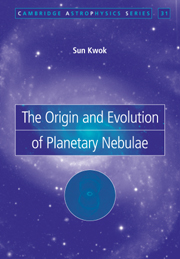Book contents
- Frontmatter
- Contents
- Preface
- 1 History and overview
- 2 Ionization structure of planetary nebulae
- 3 Nebular line radiation
- 4 Nebular continuum radiation
- 5 The neutral gas component
- 6 The dust component
- 7 Observations of the central star of planetary nebulae
- 8 Morphologies of planetary nebulae
- 9 Problems and questions
- 10 Asymptotic giant branch stars – progenitors of planetary nebulae
- 11 Evolution of the central stars
- 12 Formation of planetary nebulae
- 13 Dynamical evolution of planetary nebulae
- 14 Protoplanetary nebulae – the transition objects
- 15 Evolution to the white dwarf stage
- 16 Distances to planetary nebulae
- 17 Comparison between evolutionary models and observations
- 18 PN in the galactic context
- 19 Chemical abundances
- 20 Planetary nebulae in other galaxies
- 21 Concluding remarks
- References
- Appendix List of symbols and abbreviations
- Subject index
2 - Ionization structure of planetary nebulae
Published online by Cambridge University Press: 04 November 2009
- Frontmatter
- Contents
- Preface
- 1 History and overview
- 2 Ionization structure of planetary nebulae
- 3 Nebular line radiation
- 4 Nebular continuum radiation
- 5 The neutral gas component
- 6 The dust component
- 7 Observations of the central star of planetary nebulae
- 8 Morphologies of planetary nebulae
- 9 Problems and questions
- 10 Asymptotic giant branch stars – progenitors of planetary nebulae
- 11 Evolution of the central stars
- 12 Formation of planetary nebulae
- 13 Dynamical evolution of planetary nebulae
- 14 Protoplanetary nebulae – the transition objects
- 15 Evolution to the white dwarf stage
- 16 Distances to planetary nebulae
- 17 Comparison between evolutionary models and observations
- 18 PN in the galactic context
- 19 Chemical abundances
- 20 Planetary nebulae in other galaxies
- 21 Concluding remarks
- References
- Appendix List of symbols and abbreviations
- Subject index
Summary
We begin the discussions on the physics of PN with the classical static model of PN. PN are assumed to be made up of two components: a central star and a surrounding gaseous nebula. If the star is hot enough, much of its energy will be emitted in the ultraviolet (UV). These UV photons will be able to ionize the atoms in the nebula. The electrons ejected in the ionization process provide a pool of kinetic energy for the collisional excitation of the heavy atoms (carbon, nitrogen, oxygen, etc.). Spontaneous emissions from the various excited states of different atoms and ions are responsible for the rich emission-line spectrum seen in the visible.
The first excited state of hydrogen (H) is at 10.2 eV above the ground state, corresponding to an excitation temperature (E/k) of ∼105 K. This is much higher than the typical kinetic temperatures of ∼104 K found in PN. Even for electrons with energies high enough to overcome this energy gap, the low densities in PN imply that the excitation or ionization rates by electron collisions are much slower than the spontaneous emission rate (see Section 3.4), and the collisionally excited electron will remain at an excited state for a very short time. As the result, the population of an excited state of H is determined not by collisions from below, but by the recombination between free protons and electrons and the subsequent electron cascades via spontaneous emissions.
- Type
- Chapter
- Information
- The Origin and Evolution of Planetary Nebulae , pp. 9 - 19Publisher: Cambridge University PressPrint publication year: 2000
- 3
- Cited by

